Defending the North: The Arctic’s strategic role and importance

Canada’s Arctic is vulnerable.
Defence infrastructure is outdated or non-existent. Basic internet access is erratic. And the region’s relative poverty — despite a largely untapped wealth of natural resources — makes it a tempting target for foreign actors.
Members of the Senate Committee on National Security, Defence and Veterans Affairs were exposed to the barriers of creating a strategic, strong and viable defence system in the Arctic during a fact-finding mission to Iqaluit and Cambridge Bay in Nunavut, and to Inuvik, Tuktoyaktuk and Yellowknife in the Northwest Territories that took place from October 2 to October 9, 2022.
The study is particularly timely.
Russian aggression is making its Arctic neighbours nervous, global warming is making the Arctic more accessible to sea travel — giving rise to questions of sovereignty as well as security — and the federal government has announced a plan to spend $4.9 billion over six years with more to follow as part of plans with the United States to modernize continental defence.
For the North, this represents a rare combination of attention from Southern Canada and the prospect of financial investment.
Cold comfort
There is a consensus that no foreign force is likely to march across the North Pole to invade. But there are other threats.
Foreign intelligence agents — perhaps masquerading as adventure tourists or researchers taking advantage of increasingly navigable Arctic water — may infiltrate the North intent on sabotage or spying.
Just one fibre optic link provides Inuvik — which boasts a busy civilian satellite communications array that the international community relies on — with high-speed internet, while children in Tuktoyaktuk sometimes climb the unguarded North Warning System station.
An offer you can’t refuse
There are also subtler threats.
In 2017, work finished on a 138-kilometer gravel highway linking Tuktoyaktuk on the edge of the Arctic Ocean to Inuvik. This $300-million project took four years of construction and the highway remains vulnerable to weather and climate changes; when it is closed to traffic, it cuts off the only means of transportation to and from the community.
While the highway has done much to connect the hamlet with the rest of Canada, socioeconomic challenges remain. Locals still pool medicine and Tuktoyaktuk has not escaped the alarming rise of suicide deaths in the Northwest Territories. Issues like these — persistently flagged by northern advocates but seldom addressed — also create vulnerabilities in the North.
With infrastructure so scarce, costly, needed and wanted, it is not difficult to imagine foreign firms offering to step in and “help,” thereby threatening Canada’s sovereignty.
Despite this, many northerners devote significant time to the security and sovereignty of the Arctic in adverse conditions. The Canadian Rangers — supplied only with a communications device, 200 rounds of ammo a year and a .308 bolt-action rifle to ward off bears — patrol some of the country’s most inhospitable territory, even though their modest compensation sometimes results in clawbacks of other benefits.
‘Where the gold is paved with streets’
Despite the challenges, there is considerable optimism and energy in the North.
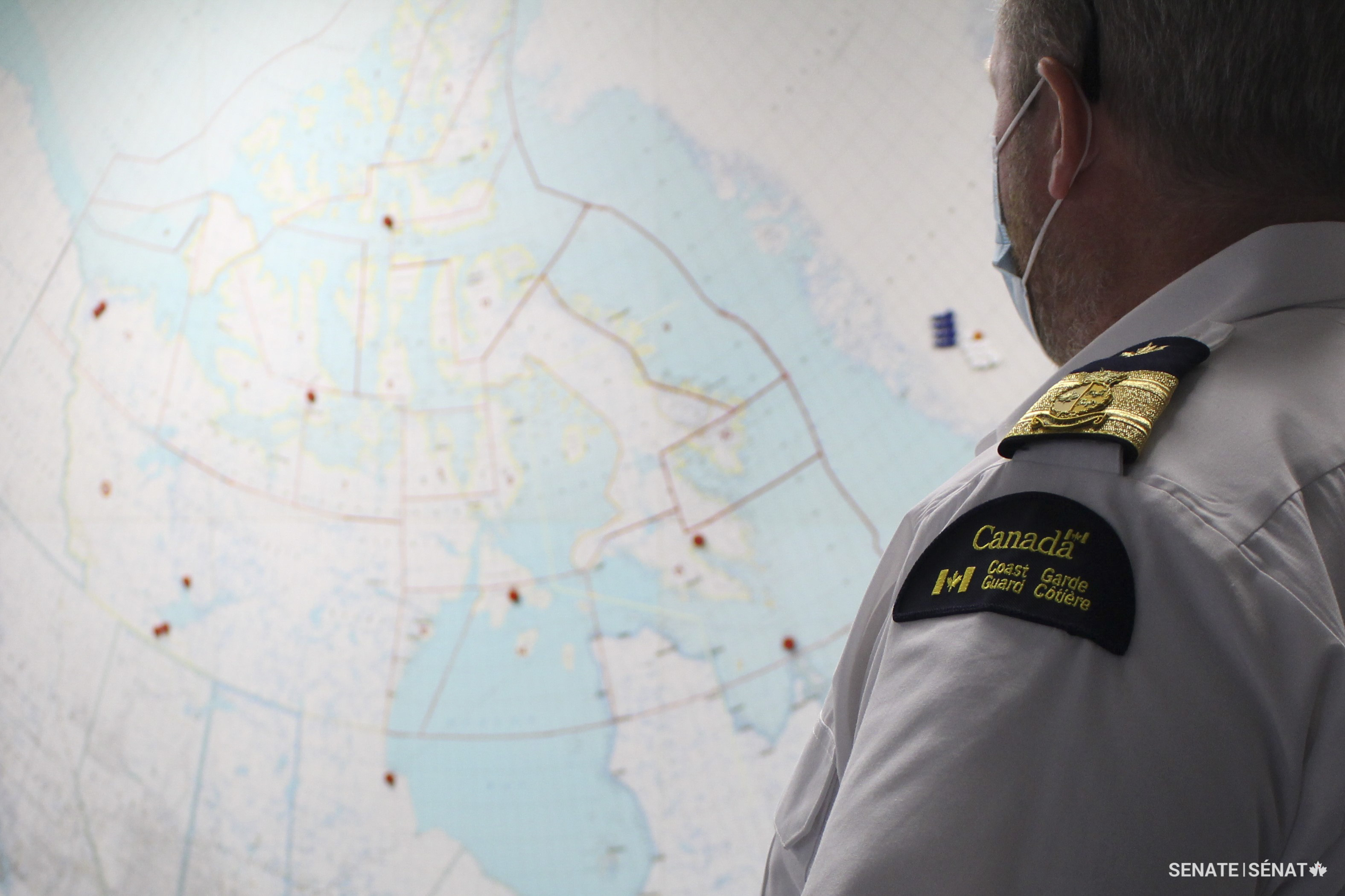 A map at a Canadian Coast Guard facility in Iqaluit, Nunavut shows the vast scope of the Arctic.
A map at a Canadian Coast Guard facility in Iqaluit, Nunavut shows the vast scope of the Arctic.
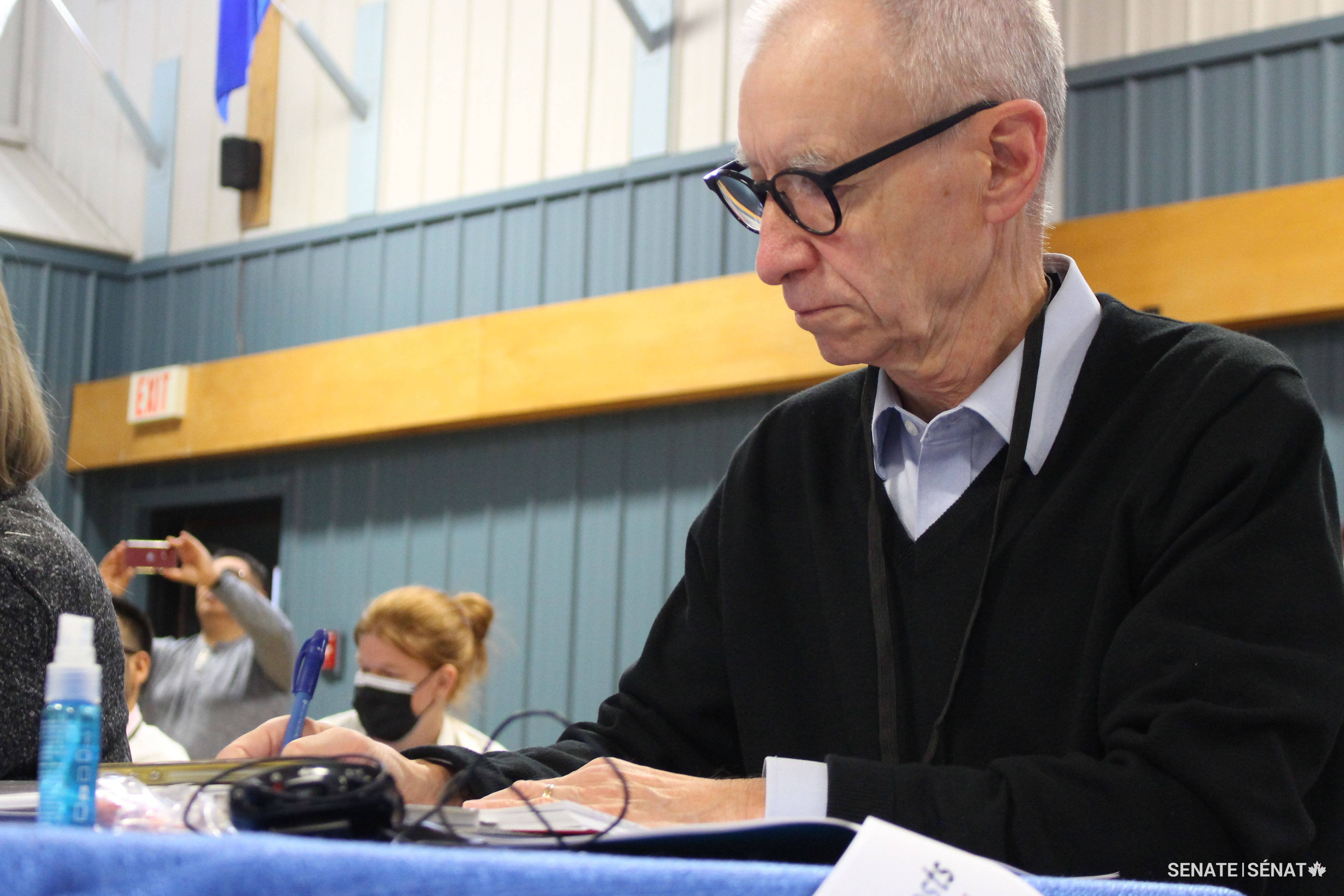 Senator Tony Dean, chair of the Senate Committee on National Security, Defence and Veterans Affairs, takes notes during the Arctic Sovereignty and Security Summit in Iqaluit, hosted by Senator Dennis Patterson.
Senator Tony Dean, chair of the Senate Committee on National Security, Defence and Veterans Affairs, takes notes during the Arctic Sovereignty and Security Summit in Iqaluit, hosted by Senator Dennis Patterson.
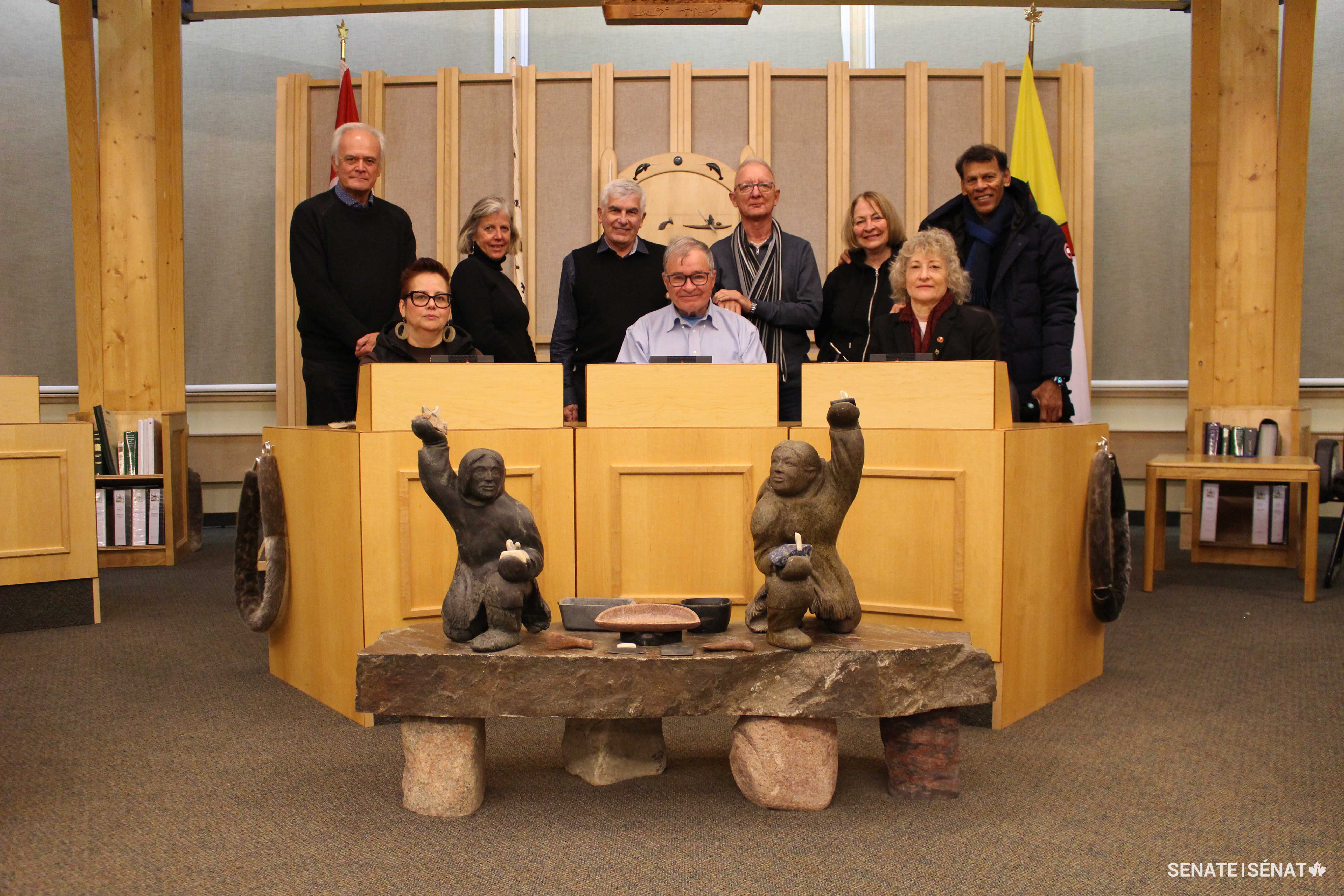 The fact-finding mission united all three northern senators in the Nunavut legislature: in the front row, from left, are senators Margaret Dawn Anderson (Northwest Territories), Dennis Patterson (Nunavut) and Pat Duncan (Yukon). In the back row, from left, are senators Peter Boehm, Marty Deacon, Clément Gignac, Pierre-Hugues Boisvenu, Donna Dasko and Hassan Yussuff.
The fact-finding mission united all three northern senators in the Nunavut legislature: in the front row, from left, are senators Margaret Dawn Anderson (Northwest Territories), Dennis Patterson (Nunavut) and Pat Duncan (Yukon). In the back row, from left, are senators Peter Boehm, Marty Deacon, Clément Gignac, Pierre-Hugues Boisvenu, Donna Dasko and Hassan Yussuff.
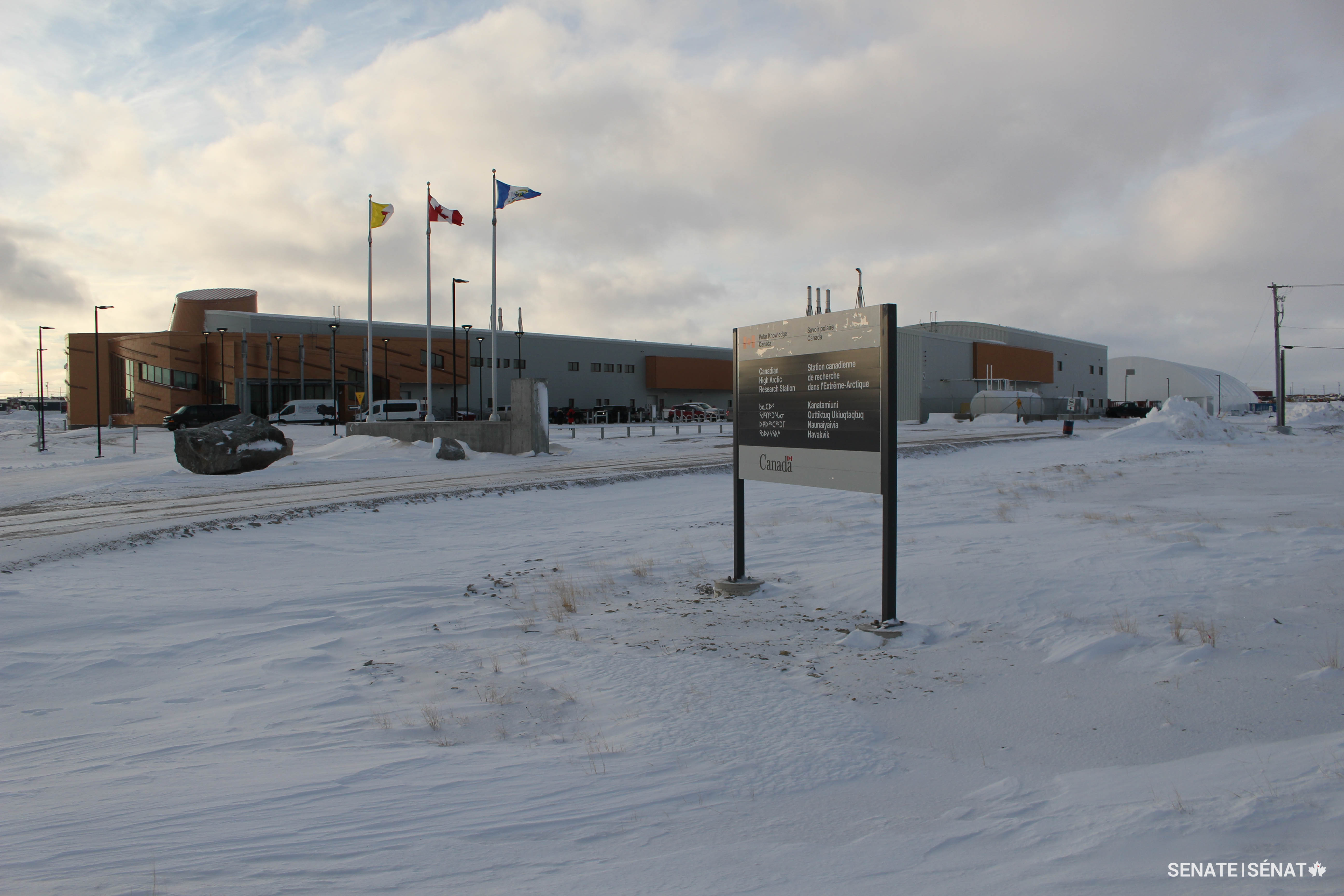 Cambridge Bay, on Victoria Island in Nunavut, might be north of the Arctic Circle but it still boasts a state-of-the-art science facility: the Canadian High Arctic Research Station, operated by Polar Knowledge Canada.
Cambridge Bay, on Victoria Island in Nunavut, might be north of the Arctic Circle but it still boasts a state-of-the-art science facility: the Canadian High Arctic Research Station, operated by Polar Knowledge Canada.
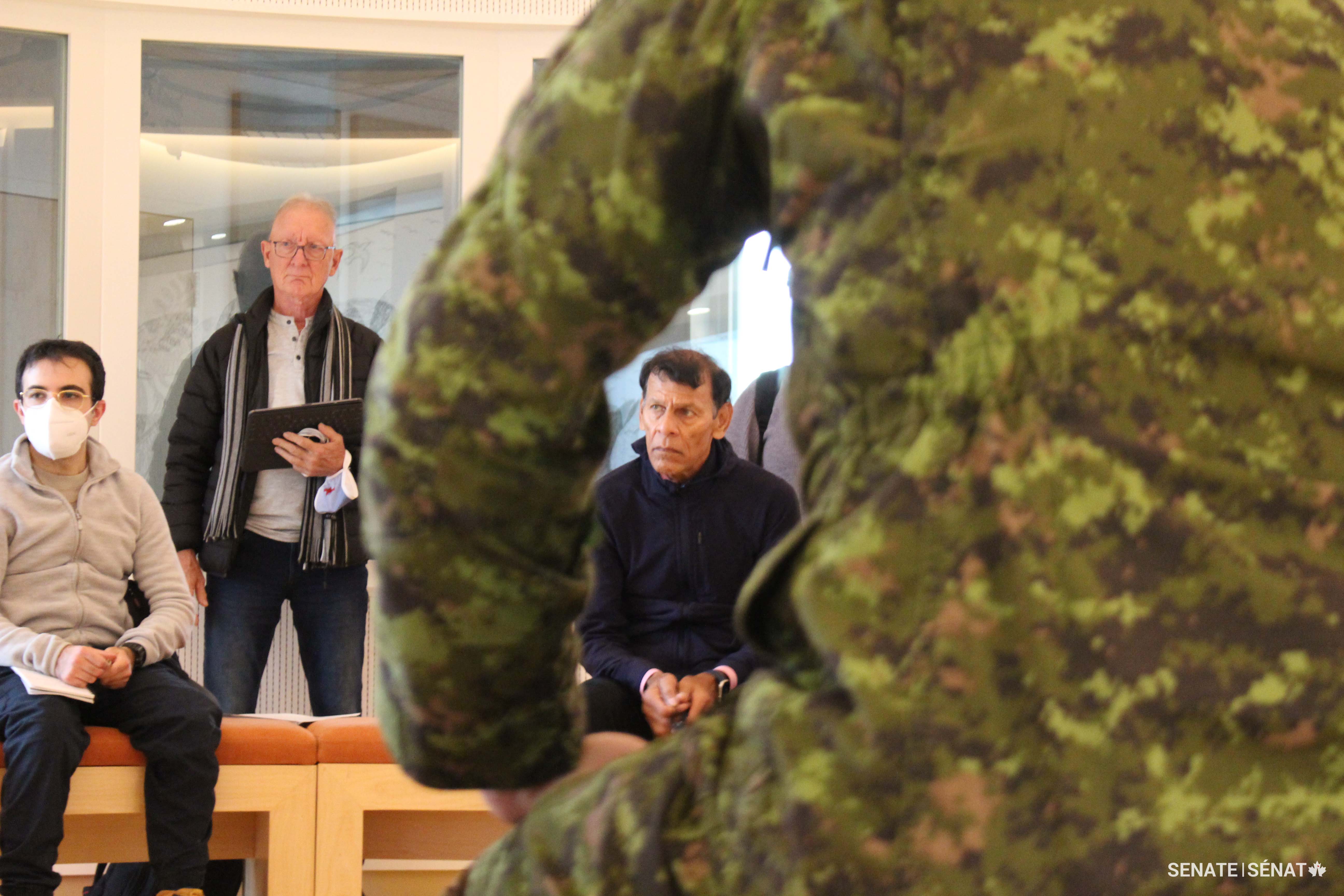 Senators Boisvenu and Yussuff listen to a presentation from Canadian Rangers at the Canadian High Arctic Research Station in Cambridge Bay. Rangers are lightly equipped and self-sufficient — and they serve loyally despite a history of forced relocation that saw Inuit summarily dispatched to the High Arctic in the name of Canadian sovereignty.
Senators Boisvenu and Yussuff listen to a presentation from Canadian Rangers at the Canadian High Arctic Research Station in Cambridge Bay. Rangers are lightly equipped and self-sufficient — and they serve loyally despite a history of forced relocation that saw Inuit summarily dispatched to the High Arctic in the name of Canadian sovereignty.
The Arctic is resource rich, with abundant natural gas and deposits of rare earth elements that are necessary for the manufacture of cell phones and clean technology like electric vehicles.
Economic and regulatory barriers to developing these resources, however, give a biting edge to a local saying that in Yellowknife the gold is paved with streets.
A Gwich’in leader told the committee that resource extraction in more prosperous times had provided his community with good jobs that funded hunting excursions and other cultural activities.
Territorial politicians, meanwhile, expressed frustration that Canada is leaving elements critical for clean technology in the ground while allowing China to dominate the market, particularly given the lack of other economic opportunities in the North.
‘In the North, by the North, for the North’
Ultimately, the committee repeatedly heard the biggest mistake that can be made is to try to resolve issues of Arctic security in Ottawa alone.
A common refrain was that solutions must come through collaboration between the federal government and the peoples of the North. One success story is the award of an operations contract for the North Warning System to Nasittuq, an Inuit-led firm. With extensions, the contract could be worth more than $1 billion and create jobs across the Arctic.
The committee was left deeply moved by its experiences in the North. Members are determined to produce a report with recommendations that respond to Canada’s security needs and take into account what senators have heard from the people who contribute so much to keeping our true north strong and free.
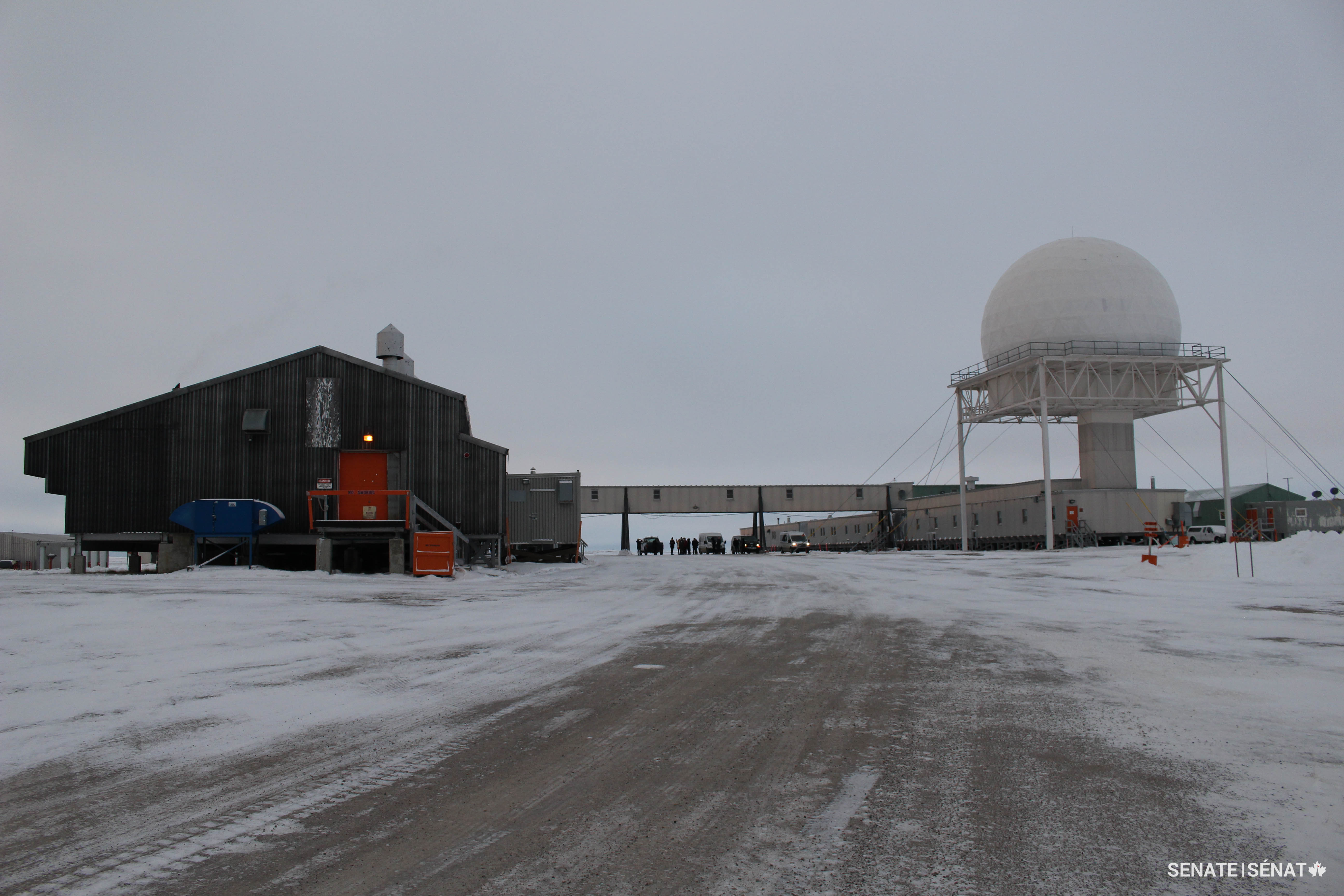 Cambridge Bay is also home to part of the North Warning System — a chain of radar stations that monitors northern approaches to Canadian and American airspace.
Cambridge Bay is also home to part of the North Warning System — a chain of radar stations that monitors northern approaches to Canadian and American airspace.
 From right, senators Anderson, Dasko, Gignac, Boisvenu and Dean pore over a map of the Arctic with Canadian Armed Forces members at an Inuvik mess hall in the Northwest Territories.
From right, senators Anderson, Dasko, Gignac, Boisvenu and Dean pore over a map of the Arctic with Canadian Armed Forces members at an Inuvik mess hall in the Northwest Territories.
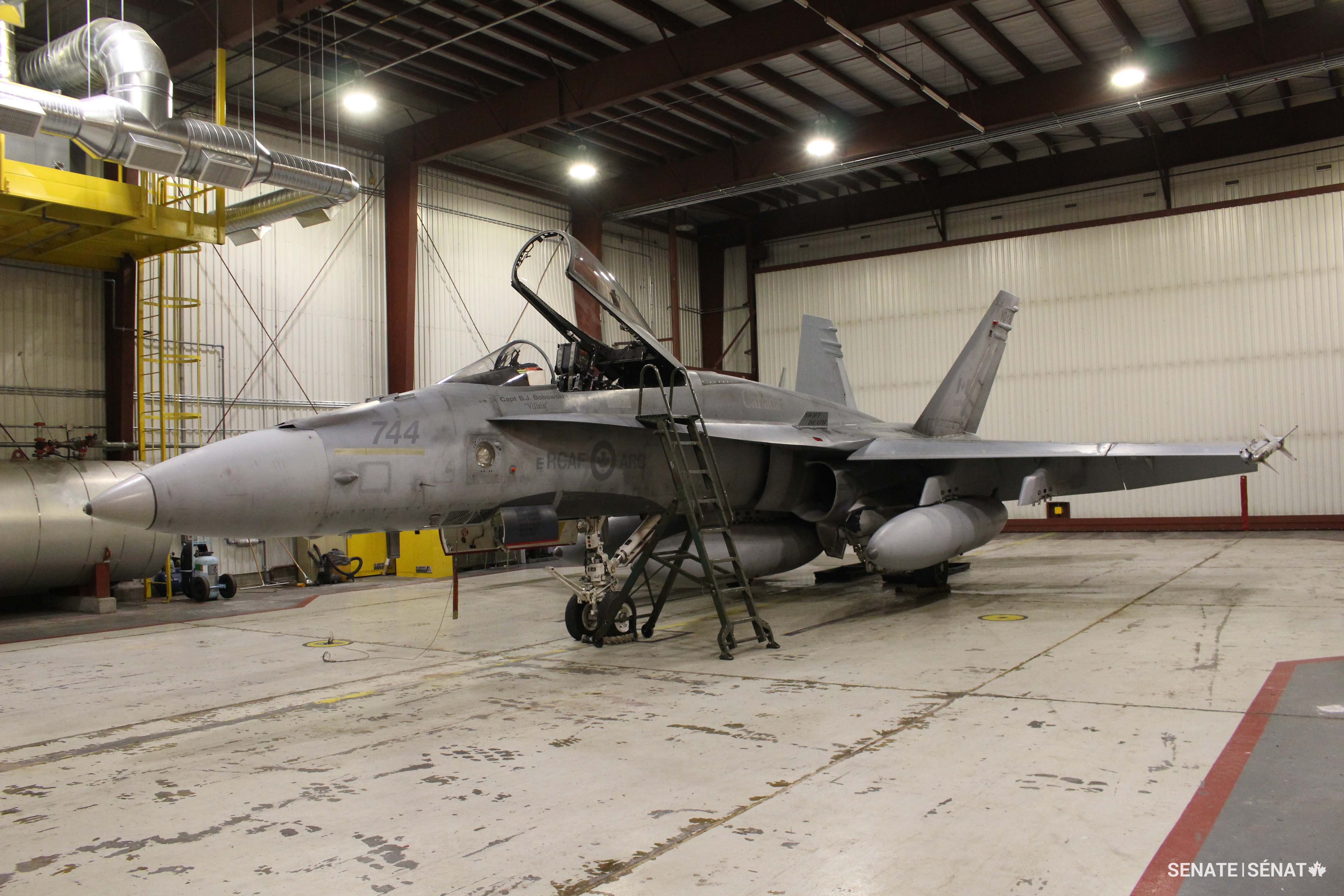 A CF-18 sits in a hangar at the Inuvik airport, which doubles as a NORAD forward operating location. CF-18s must use specially installed aircraft-carrier arresting gear to land because the runway is too short.
A CF-18 sits in a hangar at the Inuvik airport, which doubles as a NORAD forward operating location. CF-18s must use specially installed aircraft-carrier arresting gear to land because the runway is too short.
 The committee drove a bus right up to the North Warning System’s station in Tuktoyaktuk, a hamlet on the Arctic Ocean in the Northwest Territories. The area is seeing more foreign tourists — and possibly spies — whose numbers are only expected to increase as the ocean becomes more navigable.
The committee drove a bus right up to the North Warning System’s station in Tuktoyaktuk, a hamlet on the Arctic Ocean in the Northwest Territories. The area is seeing more foreign tourists — and possibly spies — whose numbers are only expected to increase as the ocean becomes more navigable.
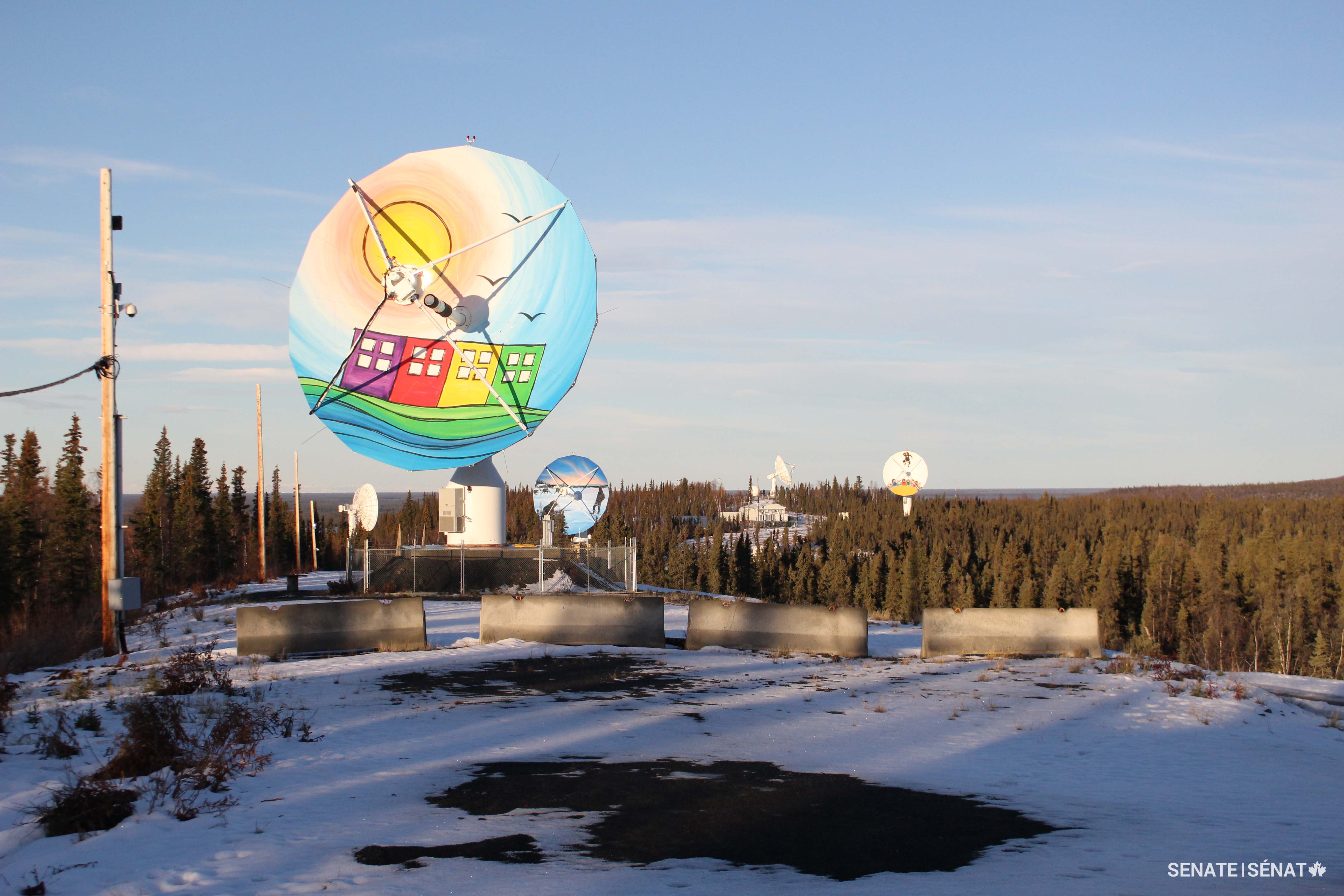 The busy Inuvik Satellite Station Facility sends and receives data from satellites for scientific, mapping, weather and surveillance purposes. Several European countries also own satellites at this facility. The dish shown here depicts Inuvik’s colourful row houses; local artists also painted scenes representing Inuvialuit, Gwich’in and Métis cultures.
The busy Inuvik Satellite Station Facility sends and receives data from satellites for scientific, mapping, weather and surveillance purposes. Several European countries also own satellites at this facility. The dish shown here depicts Inuvik’s colourful row houses; local artists also painted scenes representing Inuvialuit, Gwich’in and Métis cultures.
 Tuktoyaktuk, as seen from the North Warning System station.
Tuktoyaktuk, as seen from the North Warning System station.
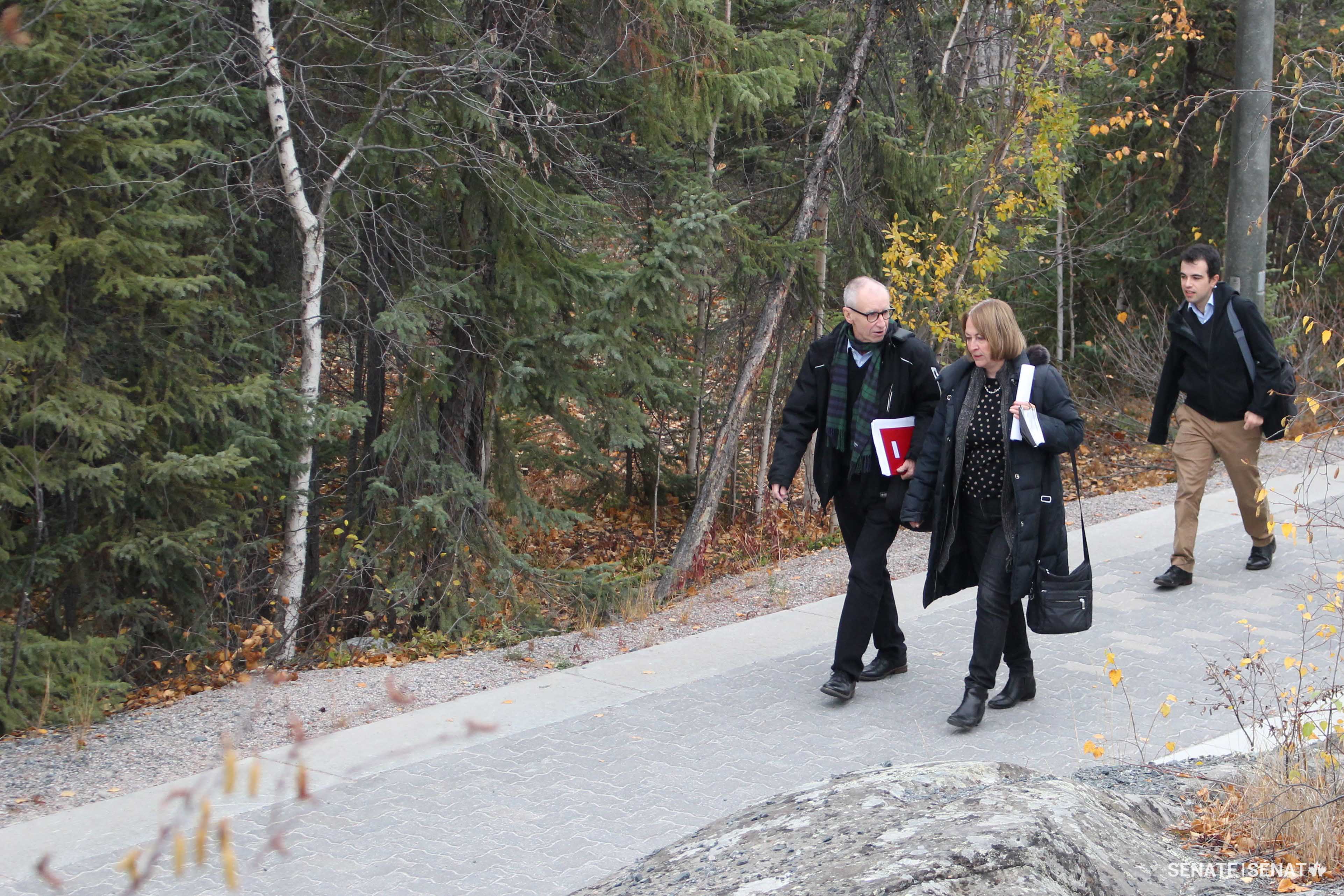 Senators Dean and Dasko confer after leaving Joint Task Forth (North) Headquarters in Yellowknife, Northwest Territories.
Senators Dean and Dasko confer after leaving Joint Task Forth (North) Headquarters in Yellowknife, Northwest Territories.
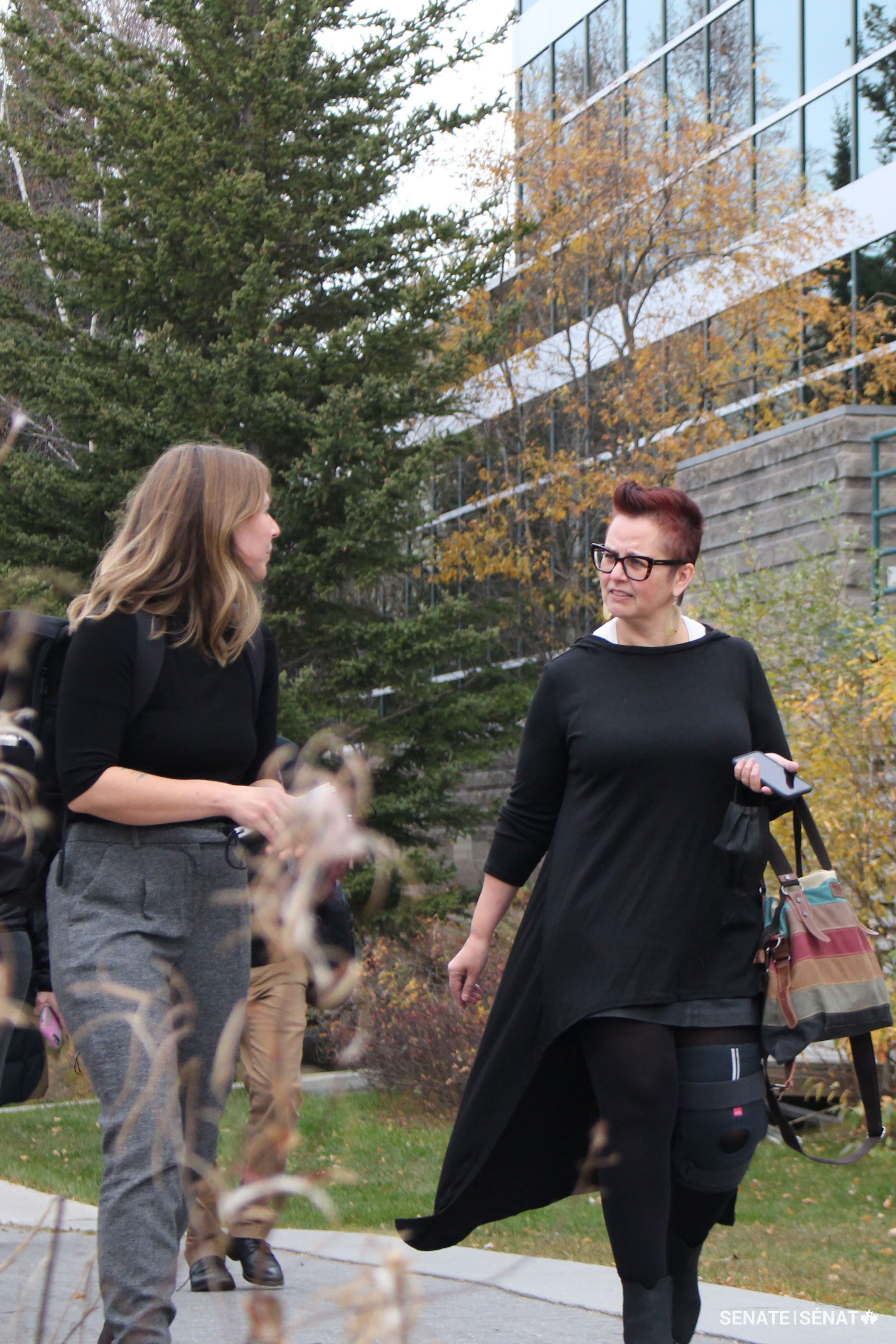 Senator Anderson and the clerk of the committee walk to the Legislative Assembly of the Northwest Territories in Yellowknife.
Senator Anderson and the clerk of the committee walk to the Legislative Assembly of the Northwest Territories in Yellowknife.
Related articles
Tags
Committee news
Defending the North: The Arctic’s strategic role and importance

Canada’s Arctic is vulnerable.
Defence infrastructure is outdated or non-existent. Basic internet access is erratic. And the region’s relative poverty — despite a largely untapped wealth of natural resources — makes it a tempting target for foreign actors.
Members of the Senate Committee on National Security, Defence and Veterans Affairs were exposed to the barriers of creating a strategic, strong and viable defence system in the Arctic during a fact-finding mission to Iqaluit and Cambridge Bay in Nunavut, and to Inuvik, Tuktoyaktuk and Yellowknife in the Northwest Territories that took place from October 2 to October 9, 2022.
The study is particularly timely.
Russian aggression is making its Arctic neighbours nervous, global warming is making the Arctic more accessible to sea travel — giving rise to questions of sovereignty as well as security — and the federal government has announced a plan to spend $4.9 billion over six years with more to follow as part of plans with the United States to modernize continental defence.
For the North, this represents a rare combination of attention from Southern Canada and the prospect of financial investment.
Cold comfort
There is a consensus that no foreign force is likely to march across the North Pole to invade. But there are other threats.
Foreign intelligence agents — perhaps masquerading as adventure tourists or researchers taking advantage of increasingly navigable Arctic water — may infiltrate the North intent on sabotage or spying.
Just one fibre optic link provides Inuvik — which boasts a busy civilian satellite communications array that the international community relies on — with high-speed internet, while children in Tuktoyaktuk sometimes climb the unguarded North Warning System station.
An offer you can’t refuse
There are also subtler threats.
In 2017, work finished on a 138-kilometer gravel highway linking Tuktoyaktuk on the edge of the Arctic Ocean to Inuvik. This $300-million project took four years of construction and the highway remains vulnerable to weather and climate changes; when it is closed to traffic, it cuts off the only means of transportation to and from the community.
While the highway has done much to connect the hamlet with the rest of Canada, socioeconomic challenges remain. Locals still pool medicine and Tuktoyaktuk has not escaped the alarming rise of suicide deaths in the Northwest Territories. Issues like these — persistently flagged by northern advocates but seldom addressed — also create vulnerabilities in the North.
With infrastructure so scarce, costly, needed and wanted, it is not difficult to imagine foreign firms offering to step in and “help,” thereby threatening Canada’s sovereignty.
Despite this, many northerners devote significant time to the security and sovereignty of the Arctic in adverse conditions. The Canadian Rangers — supplied only with a communications device, 200 rounds of ammo a year and a .308 bolt-action rifle to ward off bears — patrol some of the country’s most inhospitable territory, even though their modest compensation sometimes results in clawbacks of other benefits.
‘Where the gold is paved with streets’
Despite the challenges, there is considerable optimism and energy in the North.
 A map at a Canadian Coast Guard facility in Iqaluit, Nunavut shows the vast scope of the Arctic.
A map at a Canadian Coast Guard facility in Iqaluit, Nunavut shows the vast scope of the Arctic.
 Senator Tony Dean, chair of the Senate Committee on National Security, Defence and Veterans Affairs, takes notes during the Arctic Sovereignty and Security Summit in Iqaluit, hosted by Senator Dennis Patterson.
Senator Tony Dean, chair of the Senate Committee on National Security, Defence and Veterans Affairs, takes notes during the Arctic Sovereignty and Security Summit in Iqaluit, hosted by Senator Dennis Patterson.
 The fact-finding mission united all three northern senators in the Nunavut legislature: in the front row, from left, are senators Margaret Dawn Anderson (Northwest Territories), Dennis Patterson (Nunavut) and Pat Duncan (Yukon). In the back row, from left, are senators Peter Boehm, Marty Deacon, Clément Gignac, Pierre-Hugues Boisvenu, Donna Dasko and Hassan Yussuff.
The fact-finding mission united all three northern senators in the Nunavut legislature: in the front row, from left, are senators Margaret Dawn Anderson (Northwest Territories), Dennis Patterson (Nunavut) and Pat Duncan (Yukon). In the back row, from left, are senators Peter Boehm, Marty Deacon, Clément Gignac, Pierre-Hugues Boisvenu, Donna Dasko and Hassan Yussuff.
 Cambridge Bay, on Victoria Island in Nunavut, might be north of the Arctic Circle but it still boasts a state-of-the-art science facility: the Canadian High Arctic Research Station, operated by Polar Knowledge Canada.
Cambridge Bay, on Victoria Island in Nunavut, might be north of the Arctic Circle but it still boasts a state-of-the-art science facility: the Canadian High Arctic Research Station, operated by Polar Knowledge Canada.
 Senators Boisvenu and Yussuff listen to a presentation from Canadian Rangers at the Canadian High Arctic Research Station in Cambridge Bay. Rangers are lightly equipped and self-sufficient — and they serve loyally despite a history of forced relocation that saw Inuit summarily dispatched to the High Arctic in the name of Canadian sovereignty.
Senators Boisvenu and Yussuff listen to a presentation from Canadian Rangers at the Canadian High Arctic Research Station in Cambridge Bay. Rangers are lightly equipped and self-sufficient — and they serve loyally despite a history of forced relocation that saw Inuit summarily dispatched to the High Arctic in the name of Canadian sovereignty.
The Arctic is resource rich, with abundant natural gas and deposits of rare earth elements that are necessary for the manufacture of cell phones and clean technology like electric vehicles.
Economic and regulatory barriers to developing these resources, however, give a biting edge to a local saying that in Yellowknife the gold is paved with streets.
A Gwich’in leader told the committee that resource extraction in more prosperous times had provided his community with good jobs that funded hunting excursions and other cultural activities.
Territorial politicians, meanwhile, expressed frustration that Canada is leaving elements critical for clean technology in the ground while allowing China to dominate the market, particularly given the lack of other economic opportunities in the North.
‘In the North, by the North, for the North’
Ultimately, the committee repeatedly heard the biggest mistake that can be made is to try to resolve issues of Arctic security in Ottawa alone.
A common refrain was that solutions must come through collaboration between the federal government and the peoples of the North. One success story is the award of an operations contract for the North Warning System to Nasittuq, an Inuit-led firm. With extensions, the contract could be worth more than $1 billion and create jobs across the Arctic.
The committee was left deeply moved by its experiences in the North. Members are determined to produce a report with recommendations that respond to Canada’s security needs and take into account what senators have heard from the people who contribute so much to keeping our true north strong and free.
 Cambridge Bay is also home to part of the North Warning System — a chain of radar stations that monitors northern approaches to Canadian and American airspace.
Cambridge Bay is also home to part of the North Warning System — a chain of radar stations that monitors northern approaches to Canadian and American airspace.
 From right, senators Anderson, Dasko, Gignac, Boisvenu and Dean pore over a map of the Arctic with Canadian Armed Forces members at an Inuvik mess hall in the Northwest Territories.
From right, senators Anderson, Dasko, Gignac, Boisvenu and Dean pore over a map of the Arctic with Canadian Armed Forces members at an Inuvik mess hall in the Northwest Territories.
 A CF-18 sits in a hangar at the Inuvik airport, which doubles as a NORAD forward operating location. CF-18s must use specially installed aircraft-carrier arresting gear to land because the runway is too short.
A CF-18 sits in a hangar at the Inuvik airport, which doubles as a NORAD forward operating location. CF-18s must use specially installed aircraft-carrier arresting gear to land because the runway is too short.
 The committee drove a bus right up to the North Warning System’s station in Tuktoyaktuk, a hamlet on the Arctic Ocean in the Northwest Territories. The area is seeing more foreign tourists — and possibly spies — whose numbers are only expected to increase as the ocean becomes more navigable.
The committee drove a bus right up to the North Warning System’s station in Tuktoyaktuk, a hamlet on the Arctic Ocean in the Northwest Territories. The area is seeing more foreign tourists — and possibly spies — whose numbers are only expected to increase as the ocean becomes more navigable.
 The busy Inuvik Satellite Station Facility sends and receives data from satellites for scientific, mapping, weather and surveillance purposes. Several European countries also own satellites at this facility. The dish shown here depicts Inuvik’s colourful row houses; local artists also painted scenes representing Inuvialuit, Gwich’in and Métis cultures.
The busy Inuvik Satellite Station Facility sends and receives data from satellites for scientific, mapping, weather and surveillance purposes. Several European countries also own satellites at this facility. The dish shown here depicts Inuvik’s colourful row houses; local artists also painted scenes representing Inuvialuit, Gwich’in and Métis cultures.
 Tuktoyaktuk, as seen from the North Warning System station.
Tuktoyaktuk, as seen from the North Warning System station.
 Senators Dean and Dasko confer after leaving Joint Task Forth (North) Headquarters in Yellowknife, Northwest Territories.
Senators Dean and Dasko confer after leaving Joint Task Forth (North) Headquarters in Yellowknife, Northwest Territories.
 Senator Anderson and the clerk of the committee walk to the Legislative Assembly of the Northwest Territories in Yellowknife.
Senator Anderson and the clerk of the committee walk to the Legislative Assembly of the Northwest Territories in Yellowknife.


